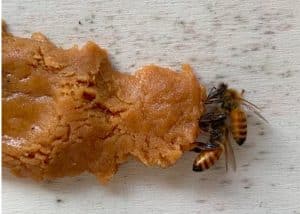Do bees hibernate in winter? Do bees manage to survive the winter or do they, like wasps, lose most of their individuals?
Bees do not hibernate and their strategy for surviving the cold winter temperatures is the glomere, a “ball” formation that worker bees assume between the honeycombs and which, with continuous movement of the bees from the outside to the inside to maintain a temperature suitable for survival, allows them to survive in the hive.
During this period honey production is suspended, because the bees have already stocked up on honey before the cold season and during the winter period they will consume these honey stocks hermetically sealed in the individual cells of the combs, which will only be opened if absolutely necessary. Among the mechanisms for survival we also see the extreme decrease in egg laying by the queen, leading to a halt in natural brooding, and the ousting of the drones, who are not equipped with a stinger and therefore unable to protect the hive and would only diminish the resources available.
During the winter, bees preserve themselves, but since the beekeeper collects some of this honey, he must store the stocks taken away by feeding, in order to ensure that the bees do not consume all the combs full of honey. The bees’ winter stocks must therefore be carefully assessed, which is generally done in autumn according to the strength of the swarm and the local climate, and then supplemented with the most suitable feed for the season.
Generally, in the winter period, the answer is found in candied fruit, a type of food that is equivalent to honey combs and that does not over-stimulate the metabolism, which would be a problem as the bee is impeded from sorties outside to defecate due to the cold weather and risks falling ill with nosemiasis. For this reason, syrup, another type of food that is equivalent to nectar for bees, and which considerably stimulates their metabolism, is not preferred in the winter season.
Bee candy is a solid, sugary foodstuff that tends to be placed on top of the coverlet, to which the bees have access through the feeding hole. This applies in the case of strong hives with almost sufficient stocks, whereas when the hive is weak the candy is placed directly inside the hive to facilitate consumption.
There are various types of candit:
- white candit to supplement stocks in winter
- protein candit, which is given between August and September to stimulate brood growth by increasing the accumulation of protein in the fat body.
Moreover, the reason for resorting to this type of feeding, which may seem artificial and unnecessary compared to the honey solution, is that the honey option, apart from being expensive, requires it to be of excellent quality to avoid creating health problems or looting.
It is fundamental to learn what our bees need and to support them in their natural development in order to ensure the best state of health for them.
In order to verify and monitor any changes in their health, it may be useful to use remote monitoring tools to keep an eye on the weight and temperature of the hive and to be able to intervene promptly in any situation. We should also remember that, as Queen Mary University of London has discovered, bees can experience both positive and negative feelings, so bees that experience hunger can fall into a kind of “pessimism” or “depression”, so let’s ensure our bees’ optimism with good nutrition!
